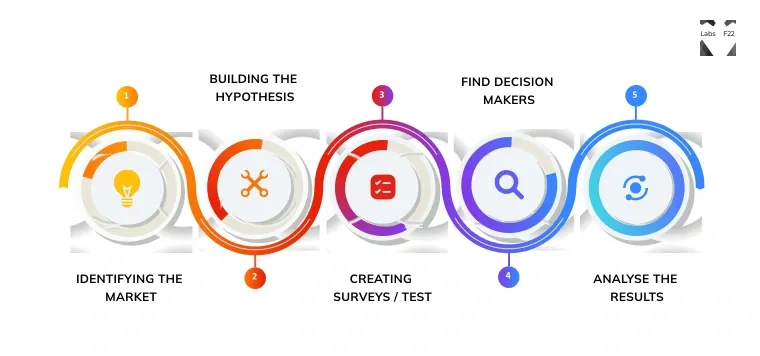How to do Market Validation in 2024 for your Startup Ideas?

Various entrepreneurs or business articles talk about market validation and its process, but only a few talk about why and how you should imply the method according to your business idea.
In this blog, we will discuss what is market validation, its importance, and various methods you can use to validate your product idea or project in the market.
What is Market Validation?
Market validation is the process of verifying whether your idea solves the pain points or issues of your targeted market. Validating your product idea enables you to reasonably anticipate if your target audience feels confident about your startup solution and whether they will purchase/subscribe to the product once it is launched in the market.
But why is Market Validation Important?
In the current market scenario, numerous startups fail within a few years of being launched in the market. But why?
According to Cbinsights, till date, 35% of the startups fail because they did not cater to the market needs. In other words, there is a 1/3rd chance of your business idea failing without market validation.
Here are the major reasons for doing market validation:
- Gauge Pros and Cons of the idea/product and build iteratively.
- Using resources efficiently.
- Acquiring early adopters for the product.
When should you do market validation?
The market validation process often occurs early in the product development process, i.e., during brainstorming sessions or when you think of building a smaller version of your product. In other words, it ideally happens before you make a vital investment in your idea or product.
Market Validation Process in 2024
At this point, you might think conducting market validation research is a challenging and rigorous process. But it isn't.
The present situation for market validation has become more nuanced & accurate because of the technological development and digitization of data which is often easily accessible.Using this opportunity, you can collaborate with people/experts and collect information or their opinions on your startup idea. But where should you start?
Here’s a step-by-step guide to the process,
Identifying the market:
The primary step in the market validation research is identifying the target market. It’s about finding your niche market and your ideal customer segment. At the initial stage of identifying your target market, it is essential to answer the following questions:
- Pain Points: Is your idea or service solving the pain points of your target customers?
- Need: Is the market looking for something like your idea or service?
- TAM & SAM: What is the size of your Total addressable Market and Serviceable Available Market?
- Demographic Factors: What demographic factors of the target market your product caters to? (It includes variables like age, gender, location, employment status, income, etc.)
- Competitors: Are there any competitors for your service or idea? If yes, who are they?
- Price: What is the pricing strategy of your competitor’s product, and is the customer willing to pay it?
How to collect Market identification & sizing data?
Initially, you can use google search (google keyword planner, google search console) to learn about your target market. After understanding your target market or your audience, you can use websites like IMF, BEA US, US census, or Oecd to collect the demographic data.
The next step is understanding your target market's and your competitors' buying behavior. You can use platforms like social media, which incorporates various tools to help you examine consumer and competitor patterns. For example, Facebook has an ad library that can track down your competitors' different patterns or strategies they use to position themselves in the market.
In the early stage, it is advisable to narrow down the audience as most entrepreneurs frequently attempt and might fail to develop a product or idea that will cater to "everyone" or "broader demography."
After analyzing your target market and narrowing it down, examining how your product or idea will fit in the market is essential. But how should you do it?
Building your hypothesis for Market Fit:
Start with listing the vision and goals of your product concept to look at the bigger picture. It will help you to reveal the presumption of your product (if you have any) and the pain points of your target audience. But how should you do it? You can take help of the following questions to analyze it:
- What is the USP of your product?
- What is your target market and customer segment?
- What are the pain points of your target market which you are solving?
- What are the pain points of your target market after using your competitor’s products?
- What is your primary marketing objective and strategy to solve the pain points of your target market?
- What will be the pricing strategy of your product or service?
- Which metrics will you focus on to position your product or service differently in the target market?
These questions will help you understand and find the right market fit according to your idea. Following this, the next step is to create a test or survey to obtain target market feedback.
Creating a Test / Survey to obtain feedback:
An excellent technique to discover the potential of your product idea is to interview individuals in your target market segment. There are several techniques that can help you procure valuable feedback for your product. Some of them include:
- Creation of newsletters and send them across through emails.
- Conduct face-to-face interviews with experts and your target audience. It is suggested to revert to your initial list from the market validation process and question any presumptions or ideas you had about your product or the market. Be receptive to the criticism you receive, and note it for later use.
- Use Google or NoCode surveys to collect feedback. After creating the questionnaire, you can spread it through online platforms like social media and your networks.
- Creation of a sample landing page about your product and run ads. It will help you examine if consumers or potential market is interested in trying your product or service.
- Distribute free trials in exchange for feedback interviews.
- Search for groups or communities (online) can help you to track down your target audience.
- Collaborate for events or virtual talks to share and get insights about your product idea.
- Visit crowdfunding events (if you have a physical product) to see if the investors are willing to fund.
These techniques will help you understand important details about your target audience, including their preferences and lifestyles. You can utilize the input to improve your offering and go through the market validation process again if you wish to iterate the segment further.
Find decision-makers in the market and engage:
The next step is to find the decision-makers in the market and engage with them. It can be done through networking and social media platforms.
Once the market's decision-makers are identified, their suggestions and opinions must be inculcated in the market validation process. Utilizing stakeholders' potential in the competitive domain can be fruitful in driving engagement and traction toward your product or idea.
This process will also help you comprehensively analyze your survey and its feedback, broadening your knowledge of the market and industry.
Analyze results and take action:
Analyzing the information gathered from the previous steps is key to molding your idea to fit in the market according to the target audience’s needs.
Sometimes, you might not get the desired results from the validation process, but it will help you track down other target market pain points that your different product idea can solve.
Let’s take the example of Mailchimp, the founders originally started a web design agency catering to corporates. The agency also provided email marketing services for small corporates. While doing this, they encountered a problem. The problem was that many small firms faced issues with email marketing and using it as an effective marketing tool. Within some time, they closed down their web design agency and focused on building a service that catered to it. And this is how MailChimp came into existence.
The market validation process helps you understand if the product idea has demand in the market. It is important to do it effectively to gain the most out of it. But why and how?

Effective Market Validation Methods for Product Ideas:
Here are five approaches that can be used to conduct effective market validation for startups:
Interviews with Ideal customer persona
Interviewing ideal customer personas is a crucial step for understanding the pain points and challenges they face as a consumer. You can use social media platforms, online communities, or business networking groups to contact them. Talk to them about their pain points your product is trying to solve and how interviewing them can be helpful in building an effective solution for the same. If they are interested, conduct a comprehensive interview and gain as much feedback as you can.
Customer personas who are typically higher up in the organization are more frequently approached because they control the buying pattern of the market. If they agree to give you an interview, it is advisable to provide them with perks like free trials, coupon codes, or subscriptions. It will help you to build a strong customer network.
But what if they don't agree to give you feedback? Don’t worry. Fortunately, consumers leave plenty of hints about their priorities, areas of concentration, and expectations from the products already present in the market.
Ensure you get a sizable number of feedback and interviews from the customer personas for analyzing your product or service in the market.
MVP Testing
Another method for the market validation process is minimum viable product. A minimum viable product, or MVP, is the earliest version of a product with only the necessary features to provide the core values and working of the product to the early clients.
In short, MVP, or minimum viable product, is used to gather input and determine whether the target market actually needs the product.
Building an MVP can take time and effort. It can also be used if your competitors have already launched the product but cannot provide solutions for the pain points of your target market. This is the broad idea you can use to analyze whether you should go forward with MVP.
Initially, you need to invest money to build a small product version to get feedback and early adopters for your product. Always remember, MVP requires minimal investment but not at the scale of building the complete product.
Early adopters are encouraged to contribute their ideas for functionality so that product developers may better understand the needs and preferences of their target market and make informed decisions about future updates. An MVP can also be used occasionally to test a product's business strategy, model, and monetization strategies.
In addition, MVP testing helps cut down the cost of development and the danger of financial failure brought on by bringing an unfavorable product to market.
Wondering how to build an MVP? Or what type of resources should you use? Or figuring out how will it work?
We have got your back. You can check out MVP ultimate guide.
Prototype Testing
Prototyping testing is the method of validating your prototype with real users to reinforce design decisions before beginning development. It is done to make the necessary modifications before development and create a product that satisfies users' needs and expectations; the objective is to identify issues and potential areas for improvement quickly.
But why should one use it to validate their startup idea?
Prototype testing provides several advantages, including helping you launch a product confidently, ensuring that your design is usable and has been verified with actual users before release, and identifying and resolving significant usability problems early in the design process.
Prototype testing is a crucial aspect of the design and product development phase. Depending on the sort of product, where you are in the development process, your objectives, and the resources available, you can test your prototype in various ways. Companies build prototypes using tools like Figma, ProtoP, and After Effects. These tools are primarily used to create a clickable prototype of your product.
Landing Page + ICP Targeting
A landing page is a standalone web page designed with a particular marketing objective in mind. It is a simple website with a "purchase" or "subscription" button and a brief product description. There are several benefits of using a landing page which include:
- They are quick and simple to make.
- Launching landing pages is independent of having a finished good or service.
- To test your offer or price strategy of your product idea, you can use several alternative landing pages to discover which is more effective.
- The world learns about your product before it even exists. Using persuasive language on your landing page, you can explain to potential buyers the distinctive value proposition your product idea offers and pique their interest.
Always remember, to efficiently use the method, you must know whom you should target. You can analyze your target market by using ICP targeting.
An ICP or ideal customer profile is a set of firmographic and behavioral traits that identify the most important customers for a business. Combining landing pages and ICP targeting can help you reach out to your target market more accurately before your product launch. Insightful right?
Analyzing search trends to size demand in the target market
Lastly, you can analyze search trends to understand the market demand for your product idea. To estimate your potential market's size and understand its trends:
- Read reports and statistics from reliable research sources that are relevant to your industry or specialty.
- Look for hashtags on social media to find out how well-liked a product or issue is. You can use this method to find out what users say about the product on social media. This is a reliable way to find consumer pain points you can address to improve your product.
- You can also use tools like Google Trends, Exploding topics, Google Keyword Planner, Ahrefs, Semrush, and Ubersuggest to understand the online search behavior of your target audience.
Market validation for startups is generally an elaborate process. If you need help in figuring this out, our team of experts are here to help you validate your product idea and ensure it meets market demands.
